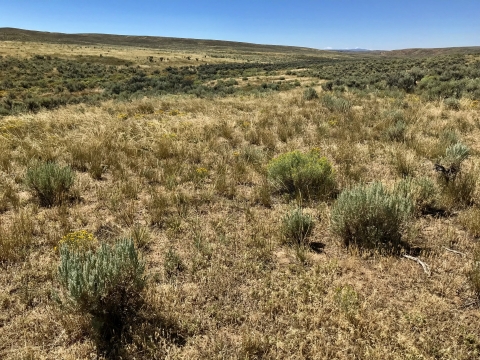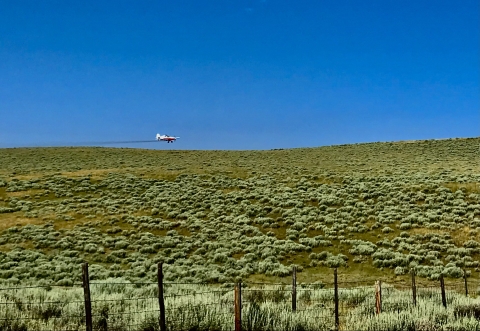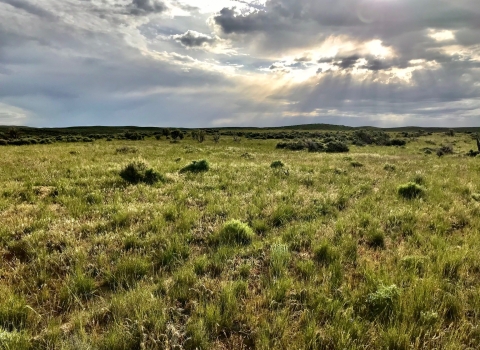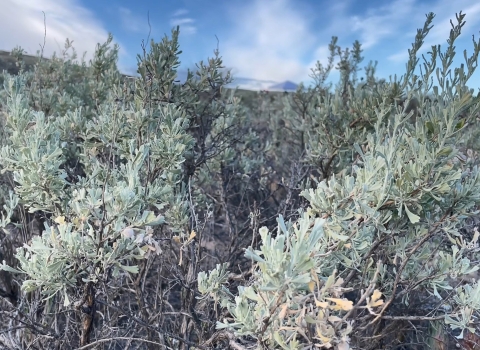The following story was written by partners at the Intermountain West Joint Venture and the original version is available on Partnering to Conserve Sagebrush Rangelands*
*When you use the above link, you are leaving the USFWS website. DOI and the bureaus do not guarantee that outside websites comply with Section 508 (Accessibility Requirements) of the Rehabilitation Act. Links also do not constitute endorsement, recommendation, or favoring by the U.S. Fish and Wildlife Service.
In the most northwestern county in Colorado, healthy sagebrush sagebrush
The western United States’ sagebrush country encompasses over 175 million acres of public and private lands. The sagebrush landscape provides many benefits to our rural economies and communities, and it serves as crucial habitat for a diversity of wildlife, including the iconic greater sage-grouse and over 350 other species.
Learn more about sagebrush habitat abounds. Large herds of big game move across the land and migratory birds such as sage thrashers and Brewer’s sparrows return, year after year, to spend the warmer months. As threats facing the West’s sagebrush biome expand, however, partners in Moffat County are working quickly to invest new conservation dollars on the ground in a way that complements ongoing efforts to sustain this valuable landscape.
Funding from the Bipartisan Infrastructure Law (BIL) has created unique opportunities to implement landscape-scale work across the West. For those living and working in northwestern Colorado, these dollars have already turned into tangible benefits for the human and wildlife communities that rely on the sagebrush ecosystem.
One of the fastest growing threats to sagebrush habitat in Moffat County is the spread of cheatgrass and other invasive annual grasses. These non-native grasses choke out native plant species, reduce habitat quality, and increase wildfire risk. Understanding the importance of keeping cheatgrass at bay, the first project conservation partners sought to implement in Colorado with BIL funding was an aerial application of the herbicide Rejuvra on 3,700 acres of sagebrush habitat to address new cheatgrass growth.
Rejuvra works by preventing germination of shallow-rooted, early-emerging invasive annual grasses like cheatgrass for up to four years. Deep-rooted perennial grasses, forbs, and shrubs that are already established are unaffected by the herbicide and often thrive from decreased competition. Partners in northwestern Colorado, including a local landowner and the U.S. Fish and Wildlife Service (USFWS), were able to apply Rejuvra in late summer of 2022. Rain came shortly after, greatly increasing the chance of success.
“A lot of the wildlife species we’re dealing with are landscape-scale species, and this funding can address some of the issues that are negatively impacting them,” said Bob Timberman, a biologist with the USFWS Partners for Fish and Wildlife Program.
Timberman’s work in this region has spanned decades and includes project implementation across ownership boundaries, keeping landscape-level conservation at the forefront. When BIL funding for strategic, landscape-scale sagebrush conservation projects became available, he was quick to apply, understanding the complementary value these funds could bring to the projects he had been working on with partners for years.
“To identify exactly where we wanted to implement this project, our Sagebrush Ecosystem Team developed prioritization tools to identify core habitat for sagebrush-obligate birds,” said Dominic Barrett, Colorado State Coordinator with the USFWS Partners for Fish and Wildlife Program. “We had already been treating the area with other practices like conifer removal, so this was the logical next step to fine tune habitat conditions and landscape. For us, this is a high priority landscape that has a lot of value for sagebrush-obligate birds.”
Because wildlife move over, under, and around fence lines, being strategic about where to put dollars on the ground is important. Thanks to good working relationships with local landowners, Barrett and Timberman were able to layer this aerial invasive annual grass treatment on top of previous work on private land, addressing multiple threats to sagebrush habitat from the ground and from the air. They hope to see ripple effects from this project to adjacent private, state, and federal lands.
“We’re always looking for win-win solutions. This project allowed us to improve habitat for sagebrush-obligate species while sustaining healthy working lands for the landowner,” said Barrett.
Other northwest Colorado partners are hoping to add additional benefits to the work Timberman, Barrett, and others implemented this year. Colorado Parks and Wildlife, local conservation districts, and additional landowners are all working to apply for funds to bring complementary projects to the area. Timberman also has plans to work with the same landowner to conduct post-treatment evaluations and utilize Bayer’s RangeView platform to monitor success.
“Like anything on a larger scale, we’re working on bringing partners together, making people’s dollars go further, and making a positive impact on the landscape and, therefore, the community,” said Timberman of the partners’ efforts.
Come fall, animals are on the move in this corner of Colorado. Migratory birds begin their southward flight, big game come down in elevation to their sagebrush winter range, and ranchers trail their livestock closer to home for the long winter months, bringing another annual cycle to a close. When the snow melts the following spring, partners hope to see an improved ecosystem waiting for those who rely on the sage.









